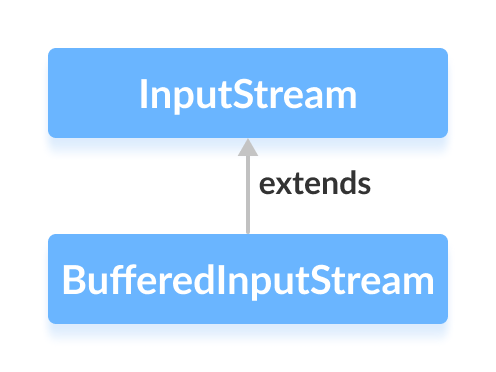java.io包的BufferedInputStream类与其他输入流一起使用,以更有效地读取数据(以字节为单位)。
它扩展了InputStream抽象类。

BufferedInputStream的工作
BufferedInputStream维护8192字节的内部缓冲区 。
在BufferedInputStream进行读取操作期间,会从磁盘读取一部分字节并将其存储在内部缓冲区中。并从内部缓冲区中逐个读取字节。
因此,减少了与磁盘的通信次数。这就是为什么使用BufferedInputStream读取字节更快的原因。
创建一个BufferedInputStream
为了创建BufferedInputStream ,我们必须首先导入java.io.BufferedInputStream包。导入包后,便可以在此处创建输入流。
// Creates a FileInputStream
FileInputStream file = new FileInputStream(String path);
// Creates a BufferedInputStream
BufferedInputStream buffer = new BufferInputStream(file);
在上面的示例中,我们创建了一个名为buffer的BufferdInputStream和名为File的FileInputStream 。
在此,内部缓冲区的默认大小为8192字节。但是,我们也可以指定内部缓冲区的大小。
// Creates a BufferedInputStream with specified size internal buffer
BufferedInputStream buffer = new BufferInputStream(file, int size);
缓冲区将有助于更快地从文件读取字节。
BufferedInputStream的方法
BufferedInputStream类为InputStream类中提供的不同方法提供实现。
read()方法
-
read()-从输入流中读取一个字节 -
read(byte[] arr)-从流中读取字节并存储在指定的数组中 -
read(byte[] arr, int start, int length)-从流中读取等于长度的字节数,并从位置start开始存储在指定的数组中
假设我们有一个名为input.txt的文件,其中包含以下内容。
This is a line of text inside the file.
让我们尝试使用BufferedInputStream读取文件。
import java.io.BufferedInputStream;
import java.io.FileInputStream;
class Main {
public static void main(String[] args) {
try {
// Creates a FileInputStream
FileInputStream file = new FileInputStream("input.txt");
// Creates a BufferedInputStream
BufferedInputStream input = new BufferedInputStream(file);
// Reads first byte from file
int i = input .read();
while (i != -1) {
System.out.print((char) i);
// Reads next byte from the file
i = input.read();
}
input.close();
}
catch (Exception e) {
e.getStackTrace();
}
}
}
输出
This is a line of text inside the file.
在上面的示例中,我们创建了一个名为buffer的缓冲输入流以及FileInputStream 。输入流与文件input.txt链接。
FileInputStream file = new FileInputStream("input.txt");
BufferedInputStream buffer = new BufferedInputStream(file);
在这里,我们使用read()方法从缓冲的读取器的内部缓冲区中读取字节数组。
available()方法
要获取输入流中可用字节的数量,我们可以使用available()方法。例如,
import java.io.FileInputStream;
import java.io.BufferedInputStream;
public class Main {
public static void main(String args[]) {
try {
// Suppose, the input.txt file contains the following text
// This is a line of text inside the file.
FileInputStream file = new FileInputStream("input.txt");
// Creates a BufferedInputStream
BufferedInputStream buffer = new BufferedInputStream(file);
// Returns the available number of bytes
System.out.println("Available bytes at the beginning: " + buffer.available());
// Reads bytes from the file
buffer.read();
buffer.read();
buffer.read();
// Returns the available number of bytes
System.out.println("Available bytes at the end: " + buffer.available());
buffer.close();
}
catch (Exception e) {
e.getStackTrace();
}
}
}
输出
Available bytes at the beginning: 39
Available bytes at the end: 36
在上面的示例中,
- 我们首先使用
available()方法检查输入流中可用字节的数量。 - 然后,我们使用了
read()方法3次,以从输入流中读取3个字节。 - 现在,在读取字节之后,我们再次检查了可用字节。这次,可用字节减少了3。
skip()方法
要丢弃并跳过指定的字节数,可以使用skip()方法。例如,
import java.io.FileInputStream;
import java.io.BufferedInputStream;
public class Main {
public static void main(String args[]) {
try {
// Suppose, the input.txt file contains the following text
// This is a line of text inside the file.
FileInputStream file = new FileInputStream("input.txt");
// Creates a BufferedInputStream
BufferedInputStream buffer = new BufferedInputStream(file);
// Skips the 5 bytes
buffer.skip(5);
System.out.println("Input stream after skipping 5 bytes:");
// Reads the first byte from input stream
int i = buffer.read();
while (i != -1) {
System.out.print((char) i);
// Reads next byte from the input stream
i = buffer.read();
}
// Closes the input stream
buffer.close();
}
catch (Exception e) {
e.getStackTrace();
}
}
}
输出
Input stream after skipping 5 bytes: is a line of text inside the file.
在上面的示例中,我们使用过skip()方法从文件输入流中跳过5个字节。因此,字节'T' , 'h' , 'i' , 's'和' '被从输入流中跳过。
close()方法
要关闭缓冲的输入流,我们可以使用close()方法。一旦调用close()方法,我们将无法使用输入流读取数据。
BufferedInputStream的其他方法
| Methods | Descriptions |
|---|---|
mark() |
mark the position in input stream up to which data has been read |
reset() |
returns the control to the point in the input stream where the mark was set |
要了解更多信息,请访问Java BufferdInputStream(官方Java文档)。